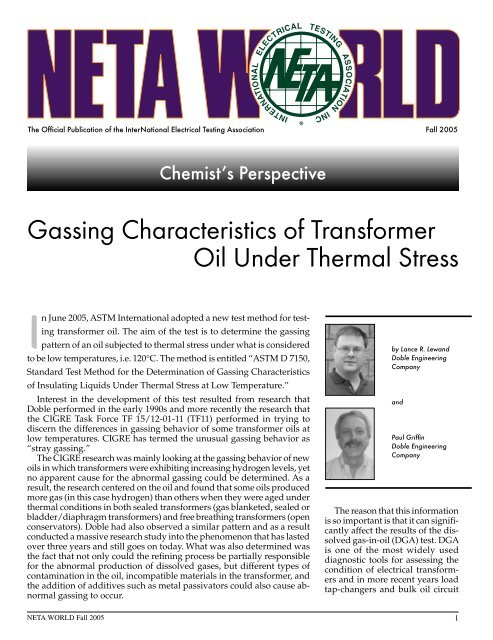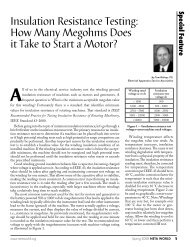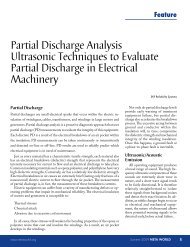Gassing Characteristics of Transformer Oil Under Thermal ... - Neta
Gassing Characteristics of Transformer Oil Under Thermal ... - Neta
Gassing Characteristics of Transformer Oil Under Thermal ... - Neta
Create successful ePaper yourself
Turn your PDF publications into a flip-book with our unique Google optimized e-Paper software.
The Official Publication <strong>of</strong> the InterNational Electrical Testing Association Fall 2005<br />
Chemist’s Perspective<br />
<strong>Gassing</strong> <strong>Characteristics</strong> <strong>of</strong> <strong>Transformer</strong><br />
<strong>Oil</strong> <strong>Under</strong> <strong>Thermal</strong> Stress<br />
In June 2005, ASTM International adopted a new test method for test-<br />
ing transformer oil. The aim <strong>of</strong> the test is to determine the gassing<br />
pattern <strong>of</strong> an oil subjected to thermal stress under what is considered<br />
to be low temperatures, i.e. 120°C. The method is entitled “ASTM D 7150,<br />
Standard Test Method for the Determination <strong>of</strong> <strong>Gassing</strong> <strong>Characteristics</strong><br />
<strong>of</strong> Insulating Liquids <strong>Under</strong> <strong>Thermal</strong> Stress at Low Temperature.”<br />
Interest in the development <strong>of</strong> this test resulted from research that<br />
Doble performed in the early 1990s and more recently the research that<br />
the CIGRE Task Force TF 15/12-01-11 (TF11) performed in trying to<br />
discern the differences in gassing behavior <strong>of</strong> some transformer oils at<br />
low temperatures. CIGRE has termed the unusual gassing behavior as<br />
“stray gassing.”<br />
The CIGRE research was mainly looking at the gassing behavior <strong>of</strong> new<br />
oils in which transformers were exhibiting increasing hydrogen levels, yet<br />
no apparent cause for the abnormal gassing could be determined. As a<br />
result, the research centered on the oil and found that some oils produced<br />
more gas (in this case hydrogen) than others when they were aged under<br />
thermal conditions in both sealed transformers (gas blanketed, sealed or<br />
bladder/diaphragm transformers) and free breathing transformers (open<br />
conservators). Doble had also observed a similar pattern and as a result<br />
conducted a massive research study into the phenomenon that has lasted<br />
over three years and still goes on today. What was also determined was<br />
the fact that not only could the refining process be partially responsible<br />
for the abnormal production <strong>of</strong> dissolved gases, but different types <strong>of</strong><br />
contamination in the oil, incompatible materials in the transformer, and<br />
the addition <strong>of</strong> additives such as metal passivators could also cause abnormal<br />
gassing to occur.<br />
by Lance R. Lewand<br />
Doble Engineering<br />
Company<br />
NETA WORLD Fall 2005 1<br />
and<br />
Paul Griffin<br />
Doble Engineering<br />
Company<br />
The reason that this information<br />
is so important is that it can significantly<br />
affect the results <strong>of</strong> the dissolved<br />
gas-in-oil (DGA) test. DGA<br />
is one <strong>of</strong> the most widely used<br />
diagnostic tools for assessing the<br />
condition <strong>of</strong> electrical transformers<br />
and in more recent years load<br />
tap-changers and bulk oil circuit
eakers. The test is very sensitive<br />
to a wide range <strong>of</strong> problems and is<br />
used to characterize incipient fault<br />
conditions. Categories <strong>of</strong> abnormal<br />
conditions such as overheating,<br />
partial discharge, and arcing can<br />
be further identified by the insulating<br />
materials involved (paper or<br />
oil) or by the energy (high, moderate,<br />
or low temperatures). DGA is<br />
ideally suited for condition-based<br />
maintenance programs as it allows<br />
early detection <strong>of</strong> problems and<br />
can then be used to follow most<br />
deterioration processes as they<br />
evolve. Then, the decision can be<br />
made as to when to perform more<br />
definitive tests to identify the<br />
specific problem or take remedial<br />
action. Indeed, DGA is sensitive<br />
enough that it can be used to detect<br />
problems during factory testing <strong>of</strong><br />
new transformers helping manufacturers<br />
avoid shipping defective<br />
units to the field.<br />
It is imperative that DGA results<br />
are interpreted accurately to ensure<br />
the correct action is taken concerning<br />
any incipient faults within the<br />
transformer. It is well known that<br />
oils can age differently, particularly<br />
where there is ample oxygen such<br />
as may be found in older units, or<br />
free-breathing transformers. A 1991<br />
study revealed that oils exposed to<br />
relatively low temperatures could<br />
have different gassing behaviors<br />
and oxygen consumption rates<br />
under the same controlled conditions.<br />
<strong>Gassing</strong> rates were different<br />
for two oils tested if the oxygen<br />
content was fairly low at 3000 ppm<br />
or high at 30,000 ppm and this is<br />
one <strong>of</strong> the reasons why the new<br />
ASTM D 7150 test is performed<br />
using air and nitrogen sparged<br />
samples. It was also shown that<br />
passing the dissolved gas-in-oil<br />
test for a factory heat run could<br />
depend on the oil chosen.<br />
Early Studies on <strong>Gassing</strong> Behavior<br />
In 1994, the Doble <strong>Oil</strong> Committee performed a study on the low<br />
temperature gassing behavior <strong>of</strong> an oil manufactured in France that<br />
was being used for the first time by a French transformer manufacturer.<br />
The transformer did not pass the dissolved gas-in-oil limits used by the<br />
purchaser. The manufacturer performed some tests which showed that<br />
the oil used (Shell Diala F) gassed much more than the oils they used<br />
historically. To evaluate the gassing behavior <strong>of</strong> the Shell Diala F oil in<br />
comparison to other products, air-saturated samples and some samples<br />
that had been degassed (all gases removed except for small amounts <strong>of</strong><br />
oxygen and nitrogen) were aged in ground-glass matched barrel and<br />
plunger syringes at 95ºC for 168 hours. The following oils were tested<br />
in the study:<br />
• Shell Diala F, uninhibited, manufactured in France<br />
• Esso Univolt 52, uninhibited, manufactured in France<br />
• Exxon Univolt N61, inhibited, manufactured in US<br />
• Shell Diala A, uninhibited, manufactured in US<br />
The results are provided in Table 1 (air saturated) and Table 2 after the<br />
oil had been vacuum processed.<br />
TABLE 1<br />
<strong>Gassing</strong> <strong>Characteristics</strong> <strong>of</strong> New <strong>Oil</strong>s Aged at 95ºC, ppm vol./vol.<br />
<strong>Oil</strong> Hydrogen Methane Ethane Ethylene Acetylene CO CO 2 TCG<br />
Diala F 378 106 63 2 0 215 908 764<br />
Univolt 52 122 101 58 10 0 113 1414 404<br />
Diala A 81 34 20 1 0 65 608 201<br />
Univolt N61 35 0 0 0 0 46 489 81<br />
TABLE 2<br />
<strong>Gassing</strong> <strong>Characteristics</strong> <strong>of</strong> Vacuum-Processed<br />
New <strong>Oil</strong>s Aged at 95ºC, ppm vol./vol.<br />
<strong>Oil</strong> Hydrogen Methane Ethane Ethylene Acetylene CO CO 2 TCG<br />
Diala F 165 133 99 2 0 116 370 515<br />
Univolt 52 0 4 2 0 0 0 42 6<br />
The results listed in Tables 1 and 2 show clearly that the Shell Diala F<br />
product produced larger amounts <strong>of</strong> combustible gases than the other oils<br />
tested. Even when oxygen is removed or reduced in the test samples, the<br />
overall concentration <strong>of</strong> gases is reduced but the same oil still produces<br />
the largest quantity <strong>of</strong> dissolved gases. Table 2 reveals that degassing the<br />
two oils to reduce the oxygen content had a much greater effect on the<br />
Univolt 52 oil than the Diala F product. This type <strong>of</strong> experiment shows<br />
that the gassing characteristics <strong>of</strong> new oils under thermal stress can be<br />
drastically different. In the case <strong>of</strong> a transformer heat run, one oil would<br />
cause the transformer to fail the test while the other oil would not be <strong>of</strong><br />
concern.<br />
Recent Studies on <strong>Gassing</strong> Behavior<br />
Doble, with the inspiration <strong>of</strong> the CIGRE work and its own previous<br />
work, undertook a study to evaluate the gassing characteristics <strong>of</strong> oils<br />
commercially available in 2001 and 2002 and in many cases still sold<br />
today. The study was to look at a wide range <strong>of</strong> oils to determine the<br />
amount <strong>of</strong> variation.<br />
2 NETA WORLD Fall 2005
Testing was performed under the following conditions:<br />
• Air purged, 16 hours at 120°C<br />
• Air purged, 164 hours at 120°C<br />
• Nitrogen Purged, 16 hours at 120°C<br />
• Nitrogen Purged, 164 hours at 120°C<br />
The aging was performed for differing times to assess<br />
initial gassing rate and when a plateau or equilibrium<br />
rate was reached. The samples were either air<br />
or nitrogen purged to have a range <strong>of</strong> oxygen contents<br />
representative <strong>of</strong> service conditions. The aging times<br />
were as follows:<br />
• 16 hours – provides indication <strong>of</strong> initial generation<br />
<strong>of</strong> gases and would be similar to the time for a factory<br />
heat run test.<br />
• 164 hours – indicates if the gases reach a plateau or<br />
a constant rate <strong>of</strong> generation<br />
The oils were assigned a sequential number based<br />
on the total amount <strong>of</strong> combustible gases formed during<br />
the experiment with air saturated oils aged for 16<br />
hours. For example, number 1 had the least amount<br />
<strong>of</strong> total combustible gas (TCG) and number 30 the<br />
greatest amount <strong>of</strong> TCG. In some cases there was more<br />
than one product from a refiner. Only the results <strong>of</strong> the<br />
164-hour testing are presented here as this is the time<br />
that was decided upon for the ASTM method.<br />
Air Saturated Samples Aged<br />
for 164 Hours at 120°C<br />
For the samples saturated with air and aged for<br />
164 hours, the data shown in Figure 1 reveals that<br />
there is a large difference in the total combustible gas<br />
(TCG) content between some <strong>of</strong> the oils and that very<br />
significant amounts <strong>of</strong> combustible gases are formed<br />
in some cases. There were four gassing patterns that<br />
developed:<br />
• Mostly carbon monoxide<br />
• Hydrogen and carbon monoxide<br />
• Mostly hydrogen<br />
• Mixture <strong>of</strong> hydrogen, carbon monoxide, methane<br />
and ethane<br />
The predominant gas formed was hydrogen. However,<br />
other gases such as methane, ethane, ethylene,<br />
carbon monoxide, and carbon dioxide were also<br />
formed. In general, if the oxygen content remained<br />
high, the first three gassing patterns occurred (as listed<br />
above). If the oxygen was depleted, the methane and<br />
ethane were generated in greater concentrations. Ethane<br />
was not generated in significant amounts without<br />
methane. The oxygen consumption rate was quite different<br />
for the various products.<br />
Figure 1 — Total Combustible Gas<br />
<strong>of</strong> Air Saturated Samples Aged for 164 Hours<br />
Nitrogen Purged Samples Aged 164 Hours<br />
at 120°C<br />
Samples purged with nitrogen and then aged 164<br />
hours did not contain as much combustible gas as<br />
those saturated with air before aging for the same<br />
amount <strong>of</strong> time; however, there were five oils that<br />
still exhibited high concentrations <strong>of</strong> hydrogen and<br />
total combustible gases. In these cases the hydrogen<br />
made up a large percentage <strong>of</strong> the composition <strong>of</strong> the<br />
TCG.<br />
What is interesting in nitrogen-sparged samples is<br />
that the methane and ethane values are consistently<br />
low but make up a greater percentage <strong>of</strong> the TCG for<br />
more samples than was the case when there was ample<br />
oxygen at the start <strong>of</strong> aging. This is due to the fact that<br />
the hydrogen produced in nitrogen-sparged samples<br />
is not as high in concentration. Similarly, the carbon<br />
oxide gases are consistently lower for the nitrogenpurged<br />
samples than when saturated with air.<br />
Figure 2 — TCG and Hydrogen Content<br />
<strong>of</strong> Nitrogen Saturated Samples Aged for 164 Hours<br />
NETA WORLD Fall 2005 3
Conclusions<br />
• There is a new ASTM Method D 7150 that provides<br />
the protocol for determining the gassing characteristics<br />
<strong>of</strong> oils under air and nitrogen (sealed) conditions<br />
and at low temperature (120°C).<br />
• It is not meant to be a routine test method in the<br />
sense that DGA currently is. However, it can be applied<br />
in those situations where there is a question <strong>of</strong><br />
whether the oil is involved in producing the gassing<br />
that is being observed.<br />
• DGA is a very important test, but care needs to be<br />
taken in the interpretation <strong>of</strong> results to understand<br />
the low temperature gassing behavior <strong>of</strong> the oil<br />
when certain types <strong>of</strong> problems are detected. As<br />
hydrogen is <strong>of</strong>ten the predominant gas formed for<br />
the oils with the highest combustible gas generation<br />
rates, it is possible that low temperature thermal<br />
problems could be confused with low energy<br />
partial discharge activity. Stray gassing may also<br />
be mistaken for excessive gassing at modest temperatures.<br />
• Some <strong>of</strong> the “breaking in” characteristics that are observed<br />
for the gassing behavior <strong>of</strong> new transformers<br />
or newly processed transformers may be attributed<br />
to the oil and will stabilize over time.<br />
• Stray gassing can also be due to the presence <strong>of</strong><br />
contamination in the oil, the presence <strong>of</strong> incompatible<br />
materials, and the presence <strong>of</strong> additives.<br />
• It is clearly important to know the properties and<br />
characteristics <strong>of</strong> the oil in individual transformers,<br />
especially when performing DGA. Similarly, it is<br />
important to make sure the gassing characteristics<br />
<strong>of</strong> oils used to ‘top <strong>of</strong>f’ transformers are also well<br />
understood.<br />
References<br />
1. Griffin, P.J., Lewand, L. R., Heywood, R., and Lapworth,<br />
J. “<strong>Gassing</strong> <strong>Characteristics</strong> <strong>of</strong> <strong>Transformer</strong><br />
<strong>Oil</strong>s at Modest Temperatures, Part 1: <strong>Transformer</strong><br />
Experiences”, Proceedings <strong>of</strong> the Seventy-First Annual<br />
Conference <strong>of</strong> Doble Clients, 2004.<br />
2. Griffin, P.J., Lewand, L. R., Heywood, R., and Lapworth,<br />
J. “<strong>Gassing</strong> <strong>Characteristics</strong> <strong>of</strong> <strong>Transformer</strong><br />
<strong>Oil</strong>s at Modest Temperatures, Part 2: Laboratory<br />
Experiments”, Proceedings <strong>of</strong> the Seventy-First<br />
Annual Conference <strong>of</strong> Doble Clients, 2004.<br />
3. Schmidt, J., Eitner, R., and Hartwig, R., “<strong>Gassing</strong> Behavior<br />
<strong>of</strong> <strong>Transformer</strong> <strong>Oil</strong>s at Temperatures Above<br />
60ºC”, 7 th International Symposium on High Voltage<br />
Engineering, Aug. 26-30, 1991, pg. 33-36.<br />
4. Griffn, P. J., “<strong>Gassing</strong> <strong>Characteristics</strong> <strong>of</strong> New <strong>Oil</strong>s<br />
Used in Factory Heat Runs”, Doble <strong>Oil</strong> Committee<br />
Minutes, 1994, pg. 18-21.<br />
Lance Lewand received his Bachelor <strong>of</strong> Science degree from<br />
St. Mary’s College <strong>of</strong> Maryland in 1980. He has been employed<br />
by the Doble Engineering Company since 1992 and is currently<br />
the Laboratory Manager for the Doble Materials Laboratory and<br />
Product Manager for the DOMINO®. product line. Prior to his<br />
present position at Doble, he was Manager <strong>of</strong> the <strong>Transformer</strong><br />
Fluid Test Laboratory and PCB and <strong>Oil</strong> Services at MET Electrical<br />
Testing in Baltimore, MD. Mr. Lewand is a member <strong>of</strong> ASTM<br />
Committee D 27.<br />
Paul J. Griffin received his BS degree at the American International<br />
College and his MS at the University <strong>of</strong> Rhode Island. He has<br />
been employed by the Doble Engineering Company since 1978 and<br />
is currently Vice President <strong>of</strong> Laboratory Services. He is secretary<br />
<strong>of</strong> the Doble <strong>Oil</strong> Committee, a member <strong>of</strong> ASTM committee D 27,<br />
US Technical Advisor to IEC TC10 for Fluids for Electrotechanical<br />
Applications, member <strong>of</strong> the IEEE Insulating Fluid subcommittee<br />
<strong>of</strong> the <strong>Transformer</strong> committee, and a member <strong>of</strong> the CIGRE Working<br />
Group 15.01 Fluid Impregnated Insulating Systems.<br />
Article available for reprint with permission from NETA. Please inquire at neta@netaworld.org.<br />
4 NETA WORLD Fall 2005




